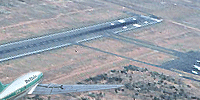 |
 |
|
||||
|
By
Wikipedia, The Terrestrial Planet Finder (TPF) is a proposed project by the National Aeronautics and Space Administration of the United States for a telescope system which is intended to detect extrasolar terrestrial planets. HistoryIn May 2002, NASA chose two TPF mission architecture concepts for further study and technology development. Each would use a different means to achieve the same goal—to block the light from a parent star in order to see its much smaller, dimmer planets. That technology challenge has been likened to finding a firefly near the beam of a distant searchlight. Additional goals of the mission would include characterizing the surfaces and atmospheres of newfound planets, and looking for the chemical signatures of life. In May 2004, both architectures were approved. Congressional spending limits under House Resolution 20 passed on January 31, 2007, by the United States House of Representatives and February 14 by the U.S. Senate have postponed the program indefinitely. The two planned architectures were:
NASA and Jet Propulsion Laboratory (JPL) were to issue calls for proposals seeking input on the development and demonstration of technologies to implement the two architectures, and on scientific research relevant to planet finding. Launch of TPF-C had been anticipated to occur around 2014, and TPF-I possibly by 2020. According to NASA's 2007 budget documentation, released on February 6, 2006, the project was deferred indefinitely. In June 2006, a House of Representatives subcommittee voted to provide funding for the TPF along with the long-sought mission to Europa, a moon of Jupiter that might harbor extraterrestrial life. However, as of June 2008, actual funding has not materialized, and TPF remains without a launch date. The European Space Agency, ESA, is considering a similar mission, called Darwin. Top 10 target stars
See also
External links
Text from Wikipedia is available under the Creative Commons Attribution/Share-Alike License; additional terms may apply.
Published in July 2009. Click here to read more articles related to aviation and space!
|

 |
|
Copyright 2004-2025 © by Airports-Worldwide.com, Vyshenskoho st. 36, Lviv 79010, Ukraine Legal Disclaimer |